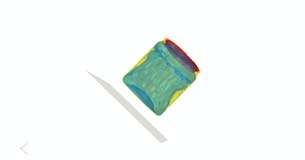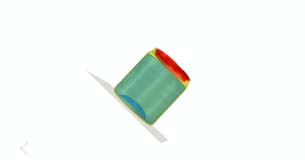Fast App: Amcor Loses Weight with Simulation
Abaqus FEA helps plastic container division slash design cycle times, reduce unit weight and enhance product performance.
Latest News
October 1, 2010
By Lynn Manning
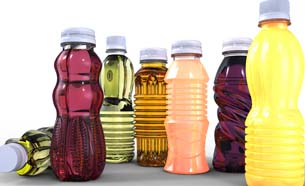 Amcor Rigid Plastics annually produces hundreds of millions of PET plastic containers custom-designed for many global drink brands. |
The competitive landscape of the consumer packaged goods (CPG) industry demands nimble adaptation strategies. Polyethylene terephthalate (PET) plastic container manufacturers are juggling business consolidation and government regulation with the need to demonstrate corporate and social responsibility. At the same time, ever-changing consumer preferences, as well as energy and raw material costs, are driving an exponential expansion of product portfolios. The PET customer is demanding that manufacturers develop a wider variety of quality, innovative containers in ever-shorter time periods and at lower unit prices.
To meet these challenges, the largest supplier of PET containers, Amcor’s Rigid Plastics Division (renamed from Amcor PET after its parent bought Alcan in late 2009), has found a way to significantly reduce costs while adhering to industry performance standards. The company uses product lifecycle management (PLM) solutions from Dassault Systèmes to integrate 3D virtual design, finite element analysis (FEA) and collaborative product development software into the product design and development process.
The results: a 50% drop in design cycle times, enhanced communication between designers and engineers, less physical prototyping and faster time-to-market. In addition, there is now quicker, more creative response to customer requests for new ideas—and lighter-weight, high-performance product solutions that lower everyone’s costs all along the supply chain, from raw materials to transportation.
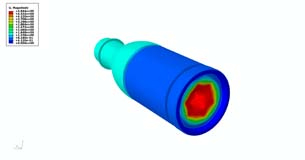 A side view of an Abaqus FEA analysis of a vacuum deformation test shows that the greatest load (red) occurs at the bottom of the container. |
Shaving a few Grams Saves Millions
Amcor’s Rigid Plastics Division has 63 facilities in 12 countries that provide packaging for many leading brands of carbonated soft drinks, juices, teas, water, condiments, salad dressings, sports drinks, soaps, shampoos, pharmaceutical and health care products. The Ann Arbor, MI-based division produces about 25 billion units of bottles, jars, cans and other product configurations per year. Multiply that number by even a few grams saved per unit, and the sustainability impact is staggering.
“A container made with too much—or too little—material can be very expensive,” says Amcor’s Advanced Engineering Services group manager, Suresh Krishnan. “Too little material can lead to containers failing, and too much can cost us a fortune. ‘Lightweighting’ our products is one of the key things that has sustained Amcor against our competition during these tough times, and computer-aided engineering (CAE), within a PLM environment, has been critical to achieving that.”
Balancing Design, Function and Cost
“A PET container is a simple product, but it’s a complex design problem to make it right,” says Krishnan. For example, the popular 2-liter carbonated soft-drink bottle, seen on supermarket shelves everywhere, has to be custom-designed to individual brand specifications and must retain its blow-molded shape during cold-filling, carbonation, sealing, labeling, packing and shipping. Hot-filled containers need to withstand additional temperature, vacuum and pressure fluctuations (see “PET Plastic Behavior is Complex,” page xx). No container should fail if accidentally dropped, nor excessively dent or lean when stacked.
|
To cost-effectively produce such a product, Amcor’s Advanced Engineering Services group uses computer modeling to simulate the behavior of a bottle under diverse loads and stresses while it’s still in the design stage. At the core of their regimen is Abaqus Unified FEA software from SIMULIA, the Dassault Systèmes brand for simulation. Amcor employs Abaqus to generate simulation data that can guide design modifications, material thickness parameters and even manufacturing processes to reach the lightest possible result that satisfies both customer and regulatory requirements.
Based on an initial concept that the industrial design department has worked out with the customer, the design engineers start by building a 3D virtual model in Dassault Systèmes’ CATIA. They then use customized scripts and knowledge templates within CATIA to accurately determine the critically important surface area, volume and weight for the bottle’s final design.
“CATIA’s capabilities save us a lot of time,” says Krishnan. “Whenever the analysis shows that we need to make a design change, we can do so—and the model automatically adjusts to reflect that. And instead of starting a new design from scratch, we can begin with an existing design and quickly modify it.”
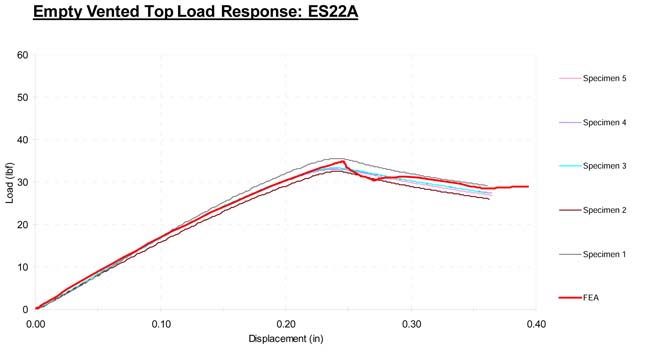 This graph of empty vented top-load response test results shows how accurately Abaqus FEA (the red line) predicted the behavior of the container. |
Next, the engineers mesh the geometry of the virtual bottle with either Hypermesh or Abaqus/CAE. Krishnan says they are increasingly using Abaqus/CAE because it has a CATIA-like look, so it’s easier for them to work with. They then bring it into Abaqus Unified FEA for physics-based performance simulation.
A typical Abaqus model for a top-load analysis, such as bottle capping or container stacking, has about 150,000 shell elements and about 350,000 degrees of freedom (DOF). A more complex, Coupled Eulerian-Lagrangian (CEL) drop analysis, which simultaneously shows the fluid-structure interactions among a container, its contents and the floor, can have up to 800,000 DOF. The group runs its analyses on a Microsoft Windows HPC server.
Amcor tried different FEA software in the past, but realized it was not getting satisfactory results. The switch to Abaqus empowered the company to begin exploring the full scope of its design challenges.
“Abaqus was the better choice for us because it offered a breadth of simulation disciplines that cover more significant performance requirements for PET containers,” says Krishnan.
PET Plastic Behavior is Complex The polyethylene terephthalate (PET) material brings challenges to the design and engineering process. PET is highly nonlinear, with biaxial properties that vary with the amount of stretching it undergoes. As a semi-crystalline thermoplastic, PET softens at a “glass transition temperature” of approximately 169º F. Above that, it becomes elastic and can be formed, a property effectively utilized in the stretch blow molding process. But when PET containers are filled with a hot liquid, they are susceptible to shrinkage back toward their “remembered” previous shape (the preform), a characteristic that has to be taken into account when designing the initial container configuration. The bottles also collapse slightly because of the vacuum pressure that results from cool-down after hot-filling. To combat these factors, the design for a hot-fill PET bottle includes “vacuum” panels for designed collapse. “We can now easily model these kinds of physics-based characteristics with Abaqus FEA, using a customized script for hydrostatic fluid elements that enables us to accurately simulate the behavior,” says Suresh Krishnan, Advanced Engineering Services group manager for Amcor. The contents of every type of PET container must also be taken into account in Amcor’s simulations, from adjustments in the density and viscosity values of liquids (from pure water to sticky paint) to the internal pressure fluctuations inherent to carbonated soft drinks. |
Kicking Around Containers via Simulation
The group began with top-loading and vacuum pressure simulations. It moved on to drop-testing, blow molding, conveyance, denting and leaning. It is currently working on pasteurization and retort (heating during sterilization) simulations. And it’s even starting in on ergonomics, to simulate the effects of a human hand putting pressure on a container.
With FEA results in hand, the Advanced Engineering Services group has a clear vocabulary for discussing the viability of a design with the industrial designers. Using multiple iterations between CATIA and Abaqus, the parties can collaborate to arrive at the best solution that validates the appearance, performance and functionality of a particular container.
Such improved communication pays off: “One of our performance metric target was to reduce the number of design revisions we made by 20% in a year,” says Krishnan. “Right now, we are well ahead of that goal.”
The benefits from virtual testing can extend beyond the testing laboratory—all the way to manufacturing, he adds: “When we achieve an optimum top-load value via simulation, we can use that data to provide actual section weights to the process engineers in the plant, so they can more easily produce the container that gives the desired performance.”
Managing the Data
It all adds up to a vast amount of simulation data. Amcor keeps track of everything the Advanced Engineering Services group generates by using Dassault Systèmes’ ENOVIA solution for collaborative product development, which facilitates the organization and easy retrieval of all CATIA and Abaqus data for each container design while managing all processes to keep them in synch.
The growth of Amcor’s physics-based simulation capabilities has been the driving force behind the company’s lightweighting initiative. Krishnan cites one example where a 63-gram container design was reduced to 43 grams.
Although Amcor still validates its virtual tests with physical testing, the ever-increasing accuracy and refinement of its computer predictions has allowed the company to decrease physical prototyping dramatically.
“We see a close match between the curves that Abaqus provides and the test results, so we’ve got a lot of confidence in simulation now,” says Krishnan. “We’ve cut our design cycle down to nine months from 12 to18, which has significantly reduced our product development costs. And we’ve gained a lot of management buy-in to our methodology.”
CAE Promotes Creativity
Another area in which the use of CAE has proved of value for Amcor is when proposing new ideas to clients, Krishnan says.
“We include animations of our Abaqus simulations in all our presentations. We can demonstrate how we create a design, perform FEA on it, and try out as many options as we want. It really frees the designers to explore whatever ideas they have,” he says, noting that any industrial design proposal can be quickly simulated. For example, if a customer puts in a request in the morning, animations can ready by that evening.
“It’s a fast-changing business, and the next new design is just around the corner,” Krishnan concludes. “Somebody else is always looking to capture that design, so we have to be really fast—and with CAE in our arsenal, we are.”
More Info:
Amcor
Dassault Systèmes
Lynn Manning is a science and technology writer based in Providence, RI. You can send comments about this article to [email protected].
Subscribe to our FREE magazine, FREE email newsletters or both!
Latest News
About the Author
DE’s editors contribute news and new product announcements to Digital Engineering.
Press releases may be sent to them via [email protected].







